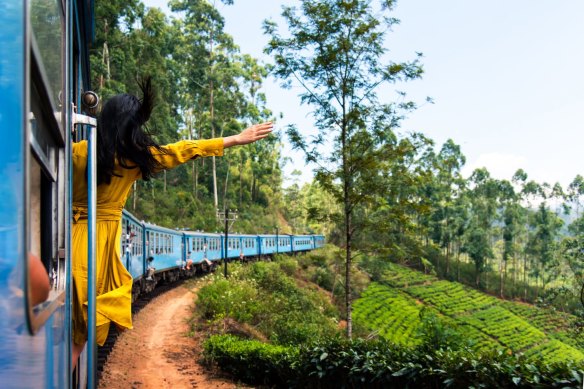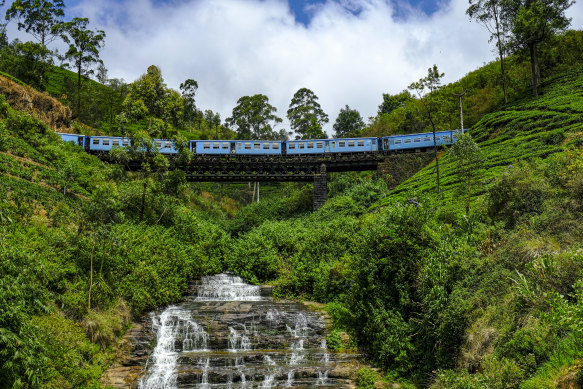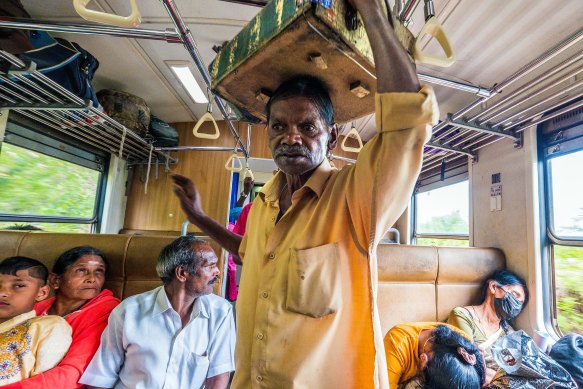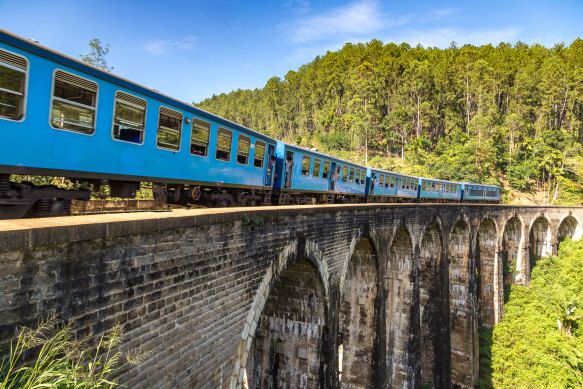One of the world’s most spectacular train rides costs less than $10
I’m fine with a little discomfort. Sitting shoulder to shoulder, a slight awkwardness here and there. Even the subtle wafts of a fellow passenger’s body odour don’t deter my mood as I’m preoccupied with other things. Hardly staring into the abyss, I’m transfixed with Sri Lanka’s countryside slowly passing me.
The island nation boasts one of the world’s most scenic train journeys. Its 1561-kilometre rail network extends like veins across the country, winding through gently sloping hills lined with tea plantations, gorges, rivers, waterfalls, viaducts and villages.

The train from Kandy to Nanu Oya is slow travel at its finest.Credit: Alamy
It’s slow travel at its finest, with some train speeds just 40km/h along the network, allowing ample time for an impromptu photoshoot.
Sri Lanka’s first railway connected the country during British rule. The railroad was built in 1864 to transport the country’s coffee trade from the Kandyan hillside in central Sri Lanka to the western port city of Colombo.
Preferred brews shifted from beans to leaves as the tea trade started booming, resulting in railroad expansion. Other agricultural developments – coconut and rubber plantations – also took over different parts of the country, with more extensions made to keep up with industrial demand.
These days, the historic railway is a people-mover and a must-do experience for train enthusiasts.
I made my first locomotive journey in Sri Lanka nine years ago, travelling from Colombo to Kandy (approximately 125 kilometres) on a classic train. I was on a backpacker budget then and didn’t even think to ask what the fare difference was between second and third class. Truth be told, not much. I sat in third class with my free-for-all, barebones chair demanding good posture. If only I could’ve maintained being positioned at a 90-degree angle for nearly four hours straight.

Some trains chug along the route at just 40km/h.Credit: iStock
Had I splurged a few more coins on a second-class ticket, I could’ve had an armrest, a slightly reclined, cushioned chair, and fans to cool me down. Or I could’ve really treated myself in first class with comfortable, numbered seating, avoiding the frantic rush of trying to nab a good seat next to a window. Unlike second and third-class passengers, first-class passengers can enjoy air-conditioned carriages; how luxe.
If only I had known about class differences and booking in advance at the station. That, and choosing to disembark at Kandy and not chug along further – rookie error. After Kandy is where the scenery, not the seating, stiffens the neck.
On this trip, I board second class in a new Chinese-manufactured S14 train, its glossy blue, white and red paint job giving the historic train journey a vivid makeover. The comforts between classes are similar, with newer trains featuring restaurant cars.

Fast food: vendors board to deliver snacks to your seat.Credit: Alamy
I embark on a three-hour journey from Kandy to Nanu Oya: the latter the stop for Nuwara Eliya, dubbed Sri Lanka’s Little England. Green highlands peppered with Tudor-style architecture, colonial buildings, pointed-roof cottages, manicured gardens and even a British-style red telephone booth of yesteryear. Even Nuwara Eliya’s cool climate mimics its alter ego.
But before I enter this mishmash of worlds 80 kilometres away, there are others to capture.
With no allocated second-class seat, I decide to mix up my experience beyond staring out of the large open window. I sit next to a local in the doorway of one of the carriages and we chat for a bit; cricket, Australia – common small-talk topics with locals. Our hands firmly grip the handles as the train rattles past villages, emerald valleys and curled plantations dotted with tea pickers in their bright saris. Even with the jostling, the smile never leaves my face passing this captivating scenery. It truly is remarkable.
I stick my head out to peer at the carriages behind; it looks like a colourful caterpillar slowly making its way around lush mountain bends. Other passengers stick out more than their necks; the fearless hang themselves outside carriage doorways, a pose that has become an Instagram regular, despite the danger.
We briefly stop at Watawala, where a vendor hops on to sell samosas. And another joins to offload his bag of the popular street-food snack, dal vada – deep-fried spiced chickpea balls – across the carriages. That’s my kind of fast-food delivery service.

The spectacular Nine Arch Bridge.Credit: iStock
Going through tunnels feels like a theme park ride. There’s collective excitement with passengers yelling “whoo!” outside windows and doorways as we snake through the darkness.
If I continue beyond my stop, I would cross the spectacular Nine Arch Bridge – arguably Sri Lanka’s most famous stop, just outside the tourist town Ella. Despite not going the distance (though I do visit the bridge later), I have my three hours of fun: cheap thrills, stunning landscapes and the transport to get me to my next destination. Better yet, the ultimate highlight of my Sri Lankan trip is only 1200 rupees, approximately $6. Loose change to get out of my comfort zone.
Details
Book your ticket in advance online at the Sri Lanka Railways site to avoid disappointment – and discomfort.
Board the train at Kandy Railway Station – one of the country’s major stations served by Sri Lanka Railways – located in the city centre and arrive 30 minutes prior to departure.
The writer was a guest of Sri Lanka Tourism Development Authority.
Sign up for the Traveller Deals newsletter
Get exclusive travel deals delivered straight to your inbox. Sign up now.